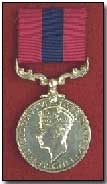Encyclopedia - Distinguished Conduct Medal
 Instigated by the British as a means of recognising acts of gallantry performed by 'other
ranks' (i.e. non-commissioned officers) during the Crimean War (from 4
December 1854), the Distinguished Conduct Medal was regarded as second only
to the Victoria Cross in prestige.
Instigated by the British as a means of recognising acts of gallantry performed by 'other
ranks' (i.e. non-commissioned officers) during the Crimean War (from 4
December 1854), the Distinguished Conduct Medal was regarded as second only
to the Victoria Cross in prestige.
Acting upon the fear during the First World War that the overwhelming demand for medals would devalue the prestige of those already available, the Military Medal was issued as an alternative to the Distinguished Conduct Medal from March 1916. Although the Distinguished Conduct Medal remained available the lesser Military Medal was usually awarded from the spring of 1916 other than for exceptional acts of bravery.
With the medal 36mm in diameter attached to a 1.25 inch wide ribbon, a silver laurelled bar was awarded for subsequent acts of bravery (although prior to 1916 these comprised plain dated bars).
The front of the medal comprised (from 1902) the head of the reigning monarch; the reverse contained the legend 'For Distinguished Conduct in the Field'. In 1993 the medal was replaced by the Conspicuous Gallantry Cross.
Recipients of the medal - which entitled the holder to append the letters 'DCM' to their name - included the Australians Pompey Elliott and John Jackson (who also won the Victoria Cross).
Awards of the medal were announced in the London Gazette, accompanied by a citation.
A 'Woolly Bear' comprised a German shrapnel shell, which burst with a cloud-like explosion.
- Did you know?
